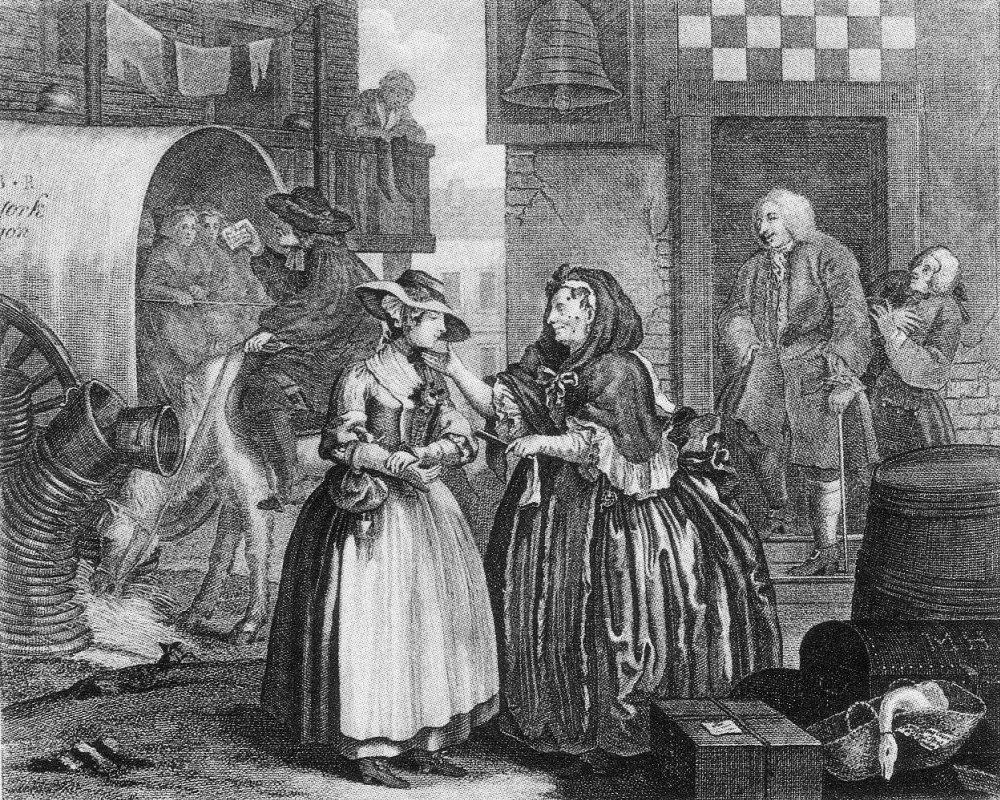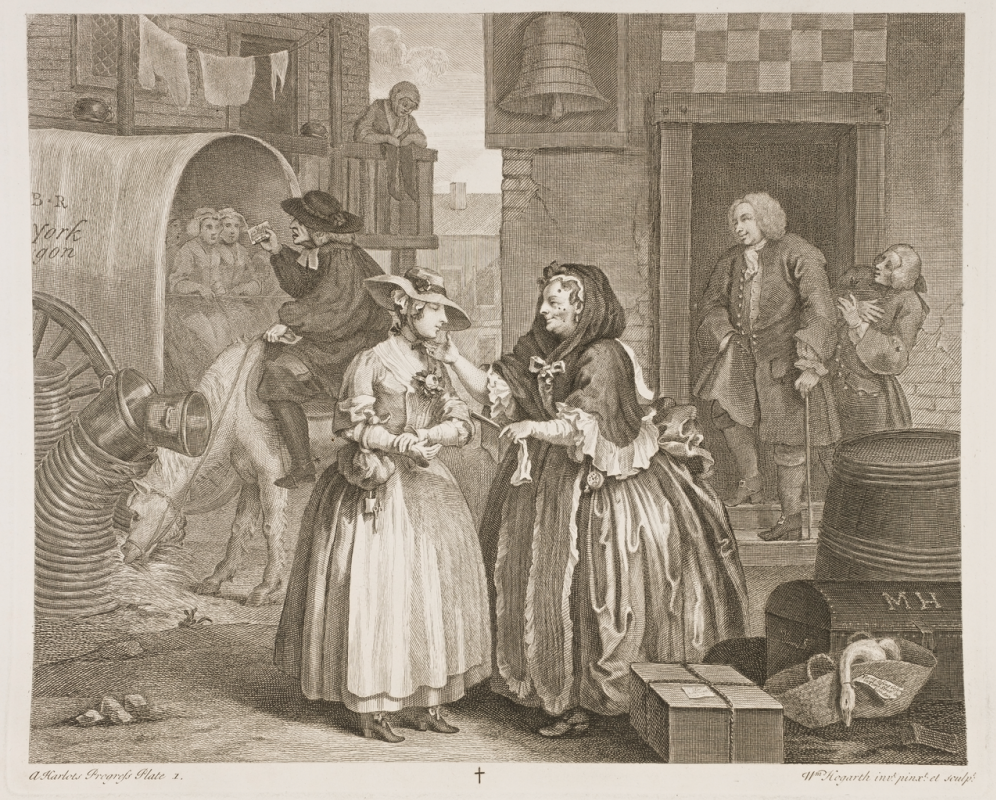log in
Enter site
Login to use Arthive functionality to the maximum
Career prostitutes. Trapped the summary
William Hogarth • Print, 1732
Description of the artwork «Career prostitutes. Trapped the summary»
"Career prostitutes" – a series of six paintings related to a single plot which brought William Hogarth the widest popularity. "Career prostitutes" was published in 1731 and 1755, the original paintings were destroyed by fire, but has preserved the autographic prints of Hogarth. In addition, episodes of "Career prostitutes" have been repeatedly reproduced on different "media" – the fans, glassware, tapestries.
"Career prostitutes" – the story of a young provincial girl, Mary (or moll), Hackabout, arrived in London in the hope of a better life. It is considered that the plot is based on real events, and partly overlaps with the novel of Daniel Defoe's "moll Flanders".
In the time of Hogarth and Defoe prostitution has become a real scourge of the British capital. Only at Covent garden during the creation of gohardasht series, there were 103 public house. Elizabeth Needham, known around London as "mother Needham", was the owner of four of them, including the famous brothel in Park place. It was a good business: in the vicinity of the capital the procuress had agents verbovka young and pretty. Mother Needham was wearing brand new silk dresses and fancy shoes with buckles, I ordered stockings and hats, and explained what to say and how to behave and promised a comfortable and cheerful life.
The first in chronological order the engraving of a series of "Career prostitutes" Hogarth depicted the meeting and the summary of provincial Mary Hackabout. After removing the glove, Needham holds out his hand to the chin of Mary, modestly potapivka look. The gesture is twofold: it kind of refreshing and new at the same time cynically contemplates it, like a horse before the sale. Not forced to wait for the "first buyers" standing on the steps of dilapidated hotels and carnivorous look on the debutante.
Interestingly, in contrast to Mary, invented by Hogarth, mother Needham was entirely real character. The city authorities, in the end, dealt with her: Elizabeth Needham was nailed to the pillory, under the hooting crowd stoned and in a few days died in the same place. Contemporary British writer Peter Ackroyd's book, "London. Biography" argues that after a loud and shameful death Needham "Hogarth had to replace her Mother Bentley", is also known for a special in the "city of lust" (Ackroyd calls London).
For professional training William Hogarth was an engraver. Apparently, from such close attention to detail and careful writing of detail. Some details are of the plot-the meaning (e.g., goose, sveshivalis the neck from the basket, indicates that Mary came from the village, and the pin cushion on her wrist indicates the profession of a seamstress), and some allegorical (discarded pile of tin vessel in the left part of the image hints at the fall of the heroine).
Important story played out, and in the left part of the image. There we see people in the wagon, an Anglican priest in a hat sitting on a horse and purposely turned away from the occurring scene. This Hogarth emphasizes that all are well aware of what is happening, but no one to care, society does not know how or simply unwilling to prevent it. Paphos Hogarth is not limited to the scourging of Vice. The artist points to the fact that prostitution is not only a syphilitic ulcers, which are inevitably overtaken Mary is "the plague" and Vice, society as a whole.
The following five engravings you will see a different Mary – rich and poor, vulgar and depraved, riddled with syphilis, and even (in the final print) – is dead. Hogarth never admitted there was supposed to be the heroine of "Career prostitute" real prototype. In 2006 for British television was filmed the movie "a harlot's progress" (Hogarth's role was played by the winner of the "Golden globe" Toby Jones), representing an interesting attempt to explain the appearance of a cycle of "Career prostitutes" personal relationship – love and the human artist and his model.
Author: Anna Yesterday
"Career prostitutes" – the story of a young provincial girl, Mary (or moll), Hackabout, arrived in London in the hope of a better life. It is considered that the plot is based on real events, and partly overlaps with the novel of Daniel Defoe's "moll Flanders".
In the time of Hogarth and Defoe prostitution has become a real scourge of the British capital. Only at Covent garden during the creation of gohardasht series, there were 103 public house. Elizabeth Needham, known around London as "mother Needham", was the owner of four of them, including the famous brothel in Park place. It was a good business: in the vicinity of the capital the procuress had agents verbovka young and pretty. Mother Needham was wearing brand new silk dresses and fancy shoes with buckles, I ordered stockings and hats, and explained what to say and how to behave and promised a comfortable and cheerful life.
The first in chronological order the engraving of a series of "Career prostitutes" Hogarth depicted the meeting and the summary of provincial Mary Hackabout. After removing the glove, Needham holds out his hand to the chin of Mary, modestly potapivka look. The gesture is twofold: it kind of refreshing and new at the same time cynically contemplates it, like a horse before the sale. Not forced to wait for the "first buyers" standing on the steps of dilapidated hotels and carnivorous look on the debutante.
Interestingly, in contrast to Mary, invented by Hogarth, mother Needham was entirely real character. The city authorities, in the end, dealt with her: Elizabeth Needham was nailed to the pillory, under the hooting crowd stoned and in a few days died in the same place. Contemporary British writer Peter Ackroyd's book, "London. Biography" argues that after a loud and shameful death Needham "Hogarth had to replace her Mother Bentley", is also known for a special in the "city of lust" (Ackroyd calls London).
For professional training William Hogarth was an engraver. Apparently, from such close attention to detail and careful writing of detail. Some details are of the plot-the meaning (e.g., goose, sveshivalis the neck from the basket, indicates that Mary came from the village, and the pin cushion on her wrist indicates the profession of a seamstress), and some allegorical (discarded pile of tin vessel in the left part of the image hints at the fall of the heroine).
Important story played out, and in the left part of the image. There we see people in the wagon, an Anglican priest in a hat sitting on a horse and purposely turned away from the occurring scene. This Hogarth emphasizes that all are well aware of what is happening, but no one to care, society does not know how or simply unwilling to prevent it. Paphos Hogarth is not limited to the scourging of Vice. The artist points to the fact that prostitution is not only a syphilitic ulcers, which are inevitably overtaken Mary is "the plague" and Vice, society as a whole.
The following five engravings you will see a different Mary – rich and poor, vulgar and depraved, riddled with syphilis, and even (in the final print) – is dead. Hogarth never admitted there was supposed to be the heroine of "Career prostitute" real prototype. In 2006 for British television was filmed the movie "a harlot's progress" (Hogarth's role was played by the winner of the "Golden globe" Toby Jones), representing an interesting attempt to explain the appearance of a cycle of "Career prostitutes" personal relationship – love and the human artist and his model.
Author: Anna Yesterday



